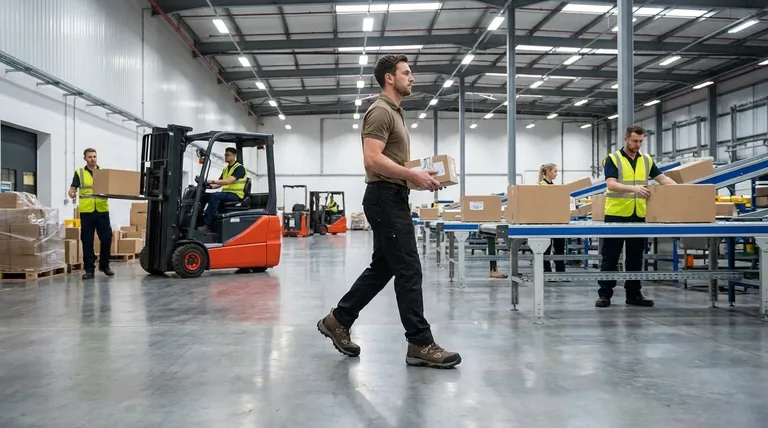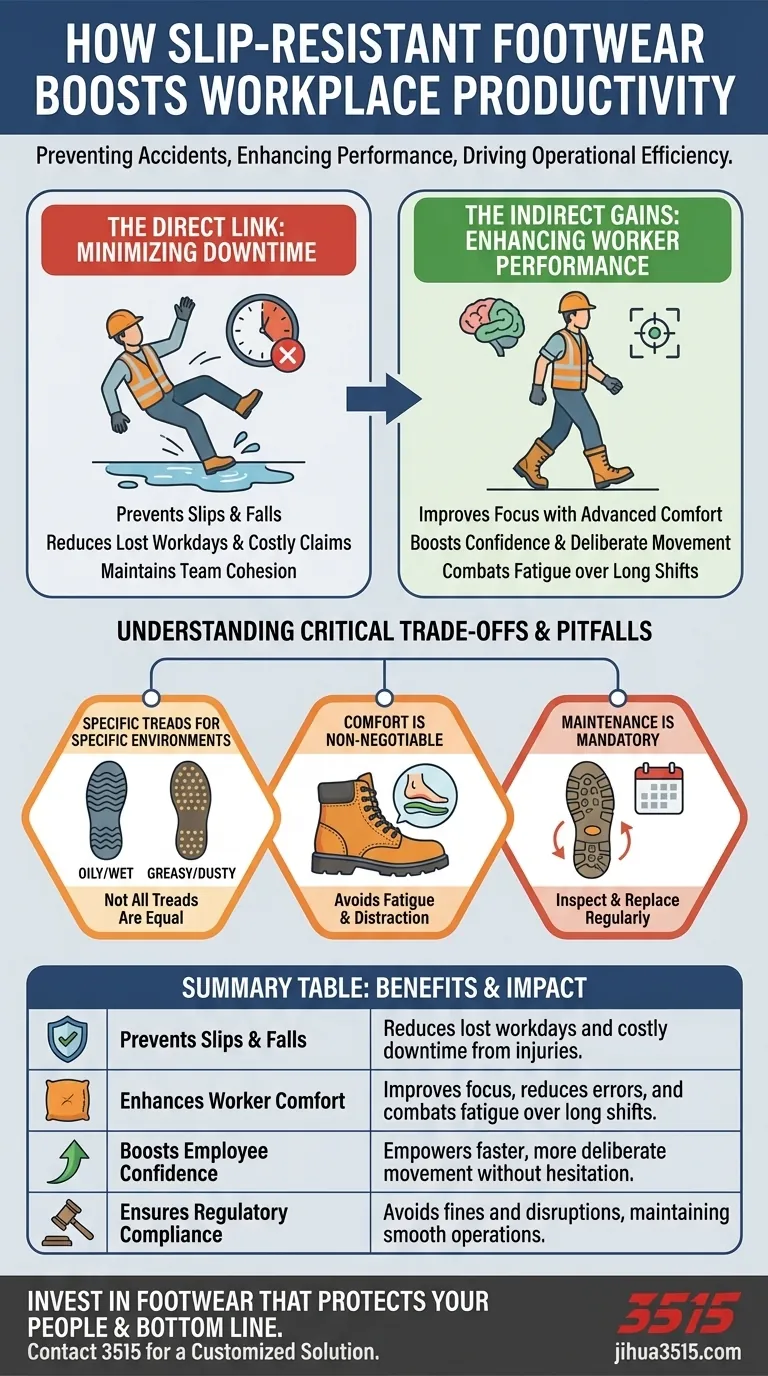Slip-resistant footwear directly improves workplace productivity by preventing the most common cause of lost workdays: slips, trips, and falls. By minimizing injuries and ensuring regulatory compliance, these shoes reduce costly downtime while features like enhanced comfort and support empower employees to perform their tasks with greater focus and endurance.
The true impact of slip-resistant footwear goes beyond accident prevention. It's a strategic tool that fosters a safer, more confident, and focused workforce, transforming a safety requirement into a tangible driver of operational efficiency.

The Direct Link: Minimizing Downtime
The most straightforward way slip-resistant footwear boosts productivity is by keeping your employees safe, healthy, and on the job. An injury is the ultimate productivity killer.
The High Cost of a Single Fall
Slips, trips, and falls are not minor incidents. According to OSHA, they account for approximately 25% of all reported injury claims and are responsible for 15% of all accidental deaths in the workplace.
Each incident represents lost workdays, potential workers' compensation claims, and the disruption of a trained employee's workflow.
Reducing Lost Workdays
Preventing an injury is far more efficient than reacting to one. Proper footwear provides superior traction on wet, oily, or uneven surfaces, drastically reducing the likelihood of an accident that could take an employee out of commission for days, weeks, or even longer.
Maintaining Team Cohesion
When a team member is absent due to injury, the impact ripples across the entire team. Other employees must cover their duties, which can lead to decreased efficiency, burnout, and a potential drop in morale, further hampering overall productivity.
The Indirect Gains: Enhancing Worker Performance
Beyond preventing major incidents, the design of quality slip-resistant footwear enhances an employee's ability to perform their job effectively throughout their entire shift.
The Foundation of Focus
Modern safety footwear often includes features like advanced cushioning and ergonomic support. When workers are comfortable and free from foot pain, they can concentrate fully on their tasks rather than their discomfort.
This sustained focus leads to fewer errors, higher quality work, and better efficiency over long hours.
The Psychology of Safety
When employees feel secure and stable on their feet, they work with more confidence. They can move more quickly and deliberately without the hesitation that comes from worrying about a potential slip.
This psychological safety allows workers to manage the minor "micro-slips" that occur during a fast-paced workday without breaking their rhythm.
Understanding the Trade-offs and Pitfalls
Simply mandating "slip-resistant shoes" is not enough. To realize the full productivity benefits, you must be aware of the potential downsides and common mistakes.
Not All Treads are Created Equal
The term "slip-resistant" is not a universal standard. A tread pattern designed for wet, smooth floors may be ineffective on greasy or dusty surfaces. Choosing the wrong type of shoe for your specific environment can provide a false sense of security.
Comfort is Non-Negotiable
If the mandated footwear is heavy, ill-fitting, or lacks proper support, employees will suffer from fatigue and pain. This discomfort can negate the productivity gains by slowing workers down and creating a new source of distraction and potential injury.
Maintenance is Mandatory
The effectiveness of slip-resistant soles degrades over time. Worn-out treads offer little to no protection. A successful footwear program must include provisions for inspecting and replacing shoes when their safety features are compromised.
How to Apply This to Your Workplace
To maximize productivity, select footwear based on the specific demands of your environment and your employees' roles.
- If your primary focus is on high-risk areas (e.g., kitchens, automotive shops): Prioritize footwear with a certified tread pattern specifically designed for oily or wet surface conditions.
- If your primary focus is on long-shift endurance (e.g., healthcare, logistics): Balance a high-traction sole with superior cushioning, arch support, and lightweight materials to combat fatigue.
- If your primary focus is on broad compliance and adoption: Offer several approved footwear options to ensure employees can find a model that fits them correctly and comfortably, which drastically increases buy-in.
Ultimately, investing in the right footwear is a direct investment in a more stable, secure, and productive workforce.
Summary Table:
| Benefit | Impact on Productivity |
|---|---|
| Prevents Slips & Falls | Reduces lost workdays and costly downtime from injuries. |
| Enhances Worker Comfort | Improves focus, reduces errors, and combats fatigue over long shifts. |
| Boosts Employee Confidence | Empowers faster, more deliberate movement without hesitation. |
| Ensures Regulatory Compliance | Avoids fines and disruptions, maintaining smooth operations. |
Ready to boost your team's productivity and safety?
As a large-scale manufacturer, 3515 produces a comprehensive range of certified slip-resistant footwear for distributors, brand owners, and bulk clients. Our production capabilities ensure you get the right footwear—with the correct tread patterns and ergonomic support—for your specific workplace environment, from kitchens and factories to healthcare and logistics.
Invest in footwear that protects your people and your bottom line. Contact 3515 today for a customized solution that enhances your operational efficiency.
Visual Guide

Related Products
- Safety Footwear Wholesale Manufacturer for Custom OEM/ODM Production
- Advanced KPU Athletic Safety Shoe with Steel Toe Cap Anti-Slip Rotary Lacing System
- Premium Suede Sport Safety Shoes for Wholesale & Bulk Orders
- Wholesale Premium Waterproof Nubuck Safety Shoes Boots
- Wholesale Customizable Safety Boots Durable & Protective Footwear Manufacturing
People Also Ask
- Is safety-toe as good as steel toe? Choose the Right Protection for Your Job
- What are the cultural perspectives on wearing shoes in the house? A Guide to Home Etiquette & Hygiene
- What do heavy duty boots do? Protect Your Feet in Demanding Work Environments
- How do safety shoes contribute to cost savings for companies? A Strategic Investment in Risk and Cost Management
- What are the differences between steel toe, composite toe, and alloy toe Wellington boots? Choose the Right Safety Toe for Your Job



















